Related Research Articles
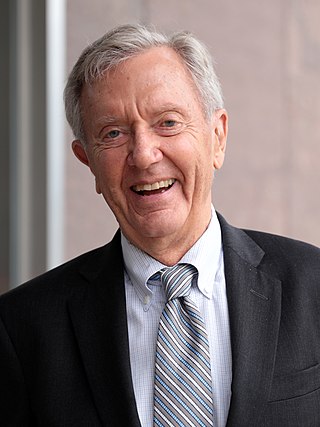
Bruce Edward Babbitt is an American attorney and politician who served as the 47th United States Secretary of the Interior from 1993 to 2001 under President Bill Clinton. He previously served as the 16th governor of Arizona from 1978 to 1987 and was a candidate for President of the United States in the 1988 Democratic primaries.

Rose Mofford was an American civil servant and politician of the Democratic Party whose career in state government spanned 51 years. Beginning her career with the State of Arizona as a secretary, Mofford worked her way up the ranks to become the state's first female secretary of state from 1977 to 1988 and the state's first female governor from 1988 to 1991.
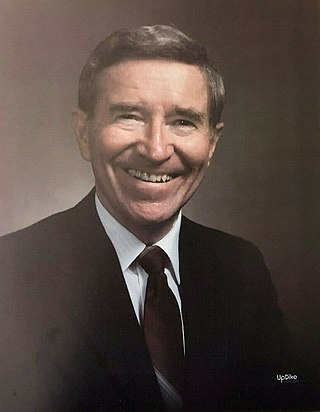
Evan Mecham was an American businessman and the 17th governor of Arizona, serving from January 5, 1987, until his impeachment conviction on April 4, 1988. A decorated veteran of World War II, Mecham was a successful automotive dealership owner and occasional newspaper publisher.
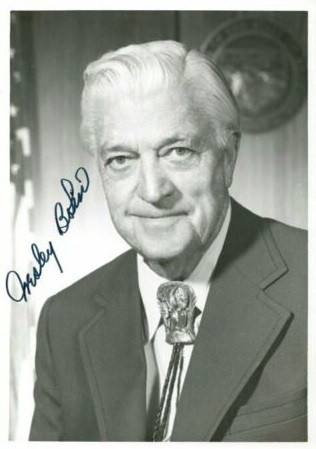
Harvey Wesley Bolin was an American Democratic Party politician who served as the 15th governor of Arizona between 1977 and 1978. His five months in office mark the shortest term in office for any Arizona governor. Prior to ascending to the Governorship, Bolin was the longest serving Secretary of State of Arizona, serving 28 years from 1949 until he succeeded to the governorship in 1977 following the resignation of his predecessor.

John Fife Symington III is an American businessman and politician who served as the 19th governor of Arizona from 1991 until his resignation in 1997. A member of the Republican Party, he resigned from office following convictions on charges of extortion and bank fraud – convictions which were later overturned. Prior to entering politics, Symington served in the United States Air Force and was stationed at Luke Air Force Base in Glendale, Arizona.

The 2006 New York gubernatorial election took place on November 7, 2006, to elect the governor and lieutenant governor of New York, concurrently with elections to the United States Senate in other states and elections to the United States House of Representatives and various state and local elections, then incumbent Republican governor George Pataki chose not to run for re-election in a fourth term. Democrat Eliot Spitzer, the New York Attorney General, won the election over former Republican state Assembly minority leader John Faso. As of 2023, this is the last time the Governor’s office in New York changed partisan control.

United States gubernatorial elections were held on November 7, 2006, in 36 states and two territories. The elections coincided with the midterm elections of the United States Senate and the United States House of Representatives.
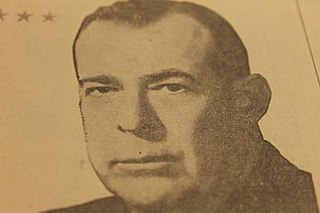
Clarence C. "Taddy" Aycock, a conservative Democrat from Franklin in St. Mary Parish, was the only three-term lieutenant governor in 20th century Louisiana history. He served from 1960 to 1972. Aycock failed in his only bid for governor in the 1971 Democratic primary. Few lieutenant governors in Louisiana have been elected directly to the governorship; former Governor Kathleen Babineaux Blanco of Lafayette, is a prominent exception.

United States gubernatorial elections were held on November 4, 1986, in 36 states and two territories. The Democrats had a net loss of eight seats during this election, which coincided with the Senate and the House elections. This was despite the Democratic trend on a federal level, making this the last midterm election until 2022 where the party of the incumbent president achieved a net gain of governorships.

The 1994 New York gubernatorial election was an election for the state governorship held on November 8, 1994. Incumbent Democratic Governor Mario Cuomo ran for a fourth term, but was defeated by Republican George Pataki in an upset victory. Pataki had previously been described by the New York Daily News as "a little-known Republican state senator." The conservative New York Post attributed the result to how voters "had grown tired of the 12-year incumbent Cuomo and his liberalism."

United States gubernatorial elections were held on November 2, 1982, in 36 states and two territories. The Democratic party had a net gain of seven seats. This election coincided with the Senate and the House elections. As of 2023, this remains the last election cycle in which a Republican won the governorship of Oregon.

The 2014 Arizona gubernatorial election was held on November 4, 2014, to elect the Governor of Arizona, concurrently with elections to the United States Senate in other states and elections to the United States House of Representatives and various state and local elections.

The 1962 United States Senate election in Arizona took place on November 6, 1962. Incumbent Democratic U.S. Senator Carl Hayden ran for reelection to a seventh term, defeating Republican State Senator Evan Mecham in the general election. Mecham became Governor of Arizona more than two decades later, and was subsequently impeached and removed from office.

The 1994 Arizona gubernatorial election took place on November 8, 1994, for the post of Governor of Arizona. Fife Symington, the incumbent Republican Governor of Arizona, defeated the Democratic nominee Eddie Basha to win a second term in office. However, Symington resigned in 1997 due to a federal indictment on corruption charges.

The 1986 Arizona gubernatorial election took place on November 4, 1986, for the post of Governor of Arizona. Republican Evan Mecham, who defeated Burton Barr for the Republican nomination, defeated the Democratic nominee and State Superintendent Carolyn Warner and independent candidate Bill Schulz. However, Mecham did not complete his full term, as he was impeached and removed from office in 1988. This was the first gubernatorial election in which La Paz County participated after separating from Yuma County in between this election and the one just before it.

The 1978 Arizona gubernatorial election took place on November 7, 1978, for the post of Governor of Arizona. Democrat Bruce Babbitt defeated Republican nominee Evan Mecham. Babbitt was the former Attorney General of Arizona, but after the death of Governor Wesley Bolin, Babbit became governor. Bolin himself ascended to office from the position of Secretary of State, meaning his replacement, Rose Mofford was not eligible to the office as she was not elected. This drama of exchanging office would continue after Babbitt's term came to an end, as Mofford would become governor and succeeded Evan Mecham, Babbitt's challenger, in 1988.
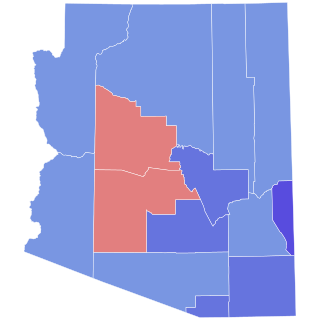
The 1964 Arizona gubernatorial election took place on November 3, 1964. Incumbent Governor Paul Fannin decided not to run for reelection to a fourth term as governor, instead deciding to successfully run for the United States Senate when incumbent U.S. Senator Barry Goldwater decided to run for President of the United States.

The 1974 Arizona gubernatorial election took place on November 5, 1974. Incumbent Governor Jack Williams decided not to run for a fourth term as governor. Former United States Ambassador to Bolivia Raúl Héctor Castro, who was the Democratic nominee in 1970, won the Democratic nomination again in 1974, and narrowly won the general election, defeating Republican nominee Russell Williams by 0.85%. Castro was sworn into his first and only term as governor on January 6, 1975.

United States gubernatorial elections were held on November 8, 2022, in 36 states and three territories. As most governors serve four-year terms, the last regular gubernatorial elections for all but two of the seats took place in 2018 U.S. gubernatorial elections. The gubernatorial elections took place concurrently with several other federal, state, and local elections, as part of the 2022 midterm elections.

The 2020 Vermont gubernatorial election was held on November 3, 2020, to elect the Governor of Vermont. As Vermont does not impose term limits upon its governors, incumbent Republican Governor Phil Scott was eligible to run for reelection to a third two-year term in office. On November 18, 2019, he confirmed that he was running for reelection, but did not yet publicly announce his campaign. On May 28, 2020, he officially announced his candidacy but stated that he would not campaign, maintain a campaign staff, or fundraise because of the state of emergency due to the COVID-19 pandemic in Vermont. The primary was held on August 11. Scott won re-election to a third term in a landslide, defeating Progressive and Democratic nominee, Lieutenant Governor David Zuckerman.
References
- 1 2 3 4 5 6 7 "The William R. Schulz Collection" (PDF). Arizona Historical Foundation. December 21, 2005. Retrieved November 22, 2017.
- ↑ Terry, Sara (October 22, 1980). "Arizona's Goldwater faces challenge from near-right". The Christian Science Monitor. Retrieved November 23, 2017.
- ↑ Coates, James (January 11, 1987). "New Governor Takes Arizona to the Right". Chicago Tribune. Retrieved November 23, 2017.
- ↑ Reich, Kenneth (October 25, 1986). "Upset of Establishment Candidates Set Stage : Offbeat's the Norm in Arizona Governor's Race". Los Angeles Times. Retrieved November 23, 2017.